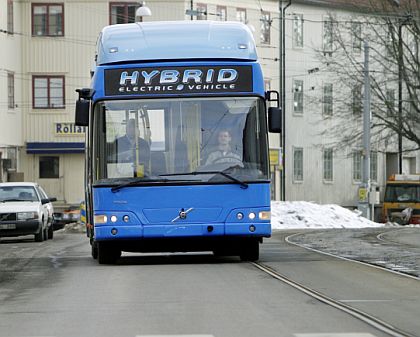
(Volvo Group premieres hybrid technology for heavy vehicles.) Nový hybridní autobus společnosti Volvo Bus v testovacím provozu.
(Volvo Group premieres hybrid technology for heavy vehicles.) Nový hybridní autobus společnosti Volvo Bus v testovacím provozu.
Volvo Group v současnosti prezentuje účinné hybridní řešení pro těžká vozidla, která nabízejí
úsporu paliva přes 35 %. "Chápeme to jako příležitost ke zrychlení vývoje v komerčně realizovatelných hybridních systémech pro těžká vozidla. To může být významné jak pro zákazníky, tak pro životní prostředí, " říká
Leif Johansson president a CEO Volvo.
Hybridní koncepce Volvo Group zajišťuje maximum úspory paliva na silnicích s častým brzděním a akcelerací - např. při městské hromadné dopravě, zásobování, svozu odpadků a stavebních pracích. Kalkulace indikují možnosti úspory paliva nad 35 %. Náklady na provoz vozidel mohou také významně klesnout snížením opotřebením brzdového systému.
"Na trhu je rostoucí zájem o snižování spotřeby paliva. To je dáno nejistotou na trhu s ropou a také účinky jejího spalování na změny klimatu. Současně mnoho zákazníků vážně posuzuje možnost snižování závislosti na naftě. Máme nyní technologii, která je zajímavá z obchodního hlediska a otevírá trh pro těžká vozidla, " říká Leif Johansson.
Zásadní část hybridního řešení je označena I-SAM. Zahrnuje kombinovaný startovací motor, pohonnou jednotku a generátor. I-SAM pracuje společně s automatickým, přestavěným mechanickým převodem, vyvinutým Volvo Group, elektronickou řídící jednotkou a konvenčním dieselovým motorem a bateriemi dobíjenými brzdící energií.
Protože spojení elektromotoru s dieselem je paralelní, mohou pracovat společně. Tak kapacita hybridu podstatně narůstá. I-SAM zajišťuje dostatečný zdroj síly ke startu a akceleraci přiměřenou rychlostí dokonce bez podílu dieselového motoru. To také účinně redukuje úroveň hluku vozidla.
"Důsledkem využití kapacity elektromotoru je možnost automatického vyřazení dieselového motoru při zastavování autobusu na zastávce nebo na křižovatkách. Přídavné funkce jako vzduchová a servo čerpadla a AC kompresory jsou zajišťovány v hybridu elektricky místo dieselem, " říká Peter Danielsson, environmental manager Volvo Bus.
Díky účinnému spojení mezi elektromotorem a dieselem může být vozidlo vybaveno menším dieselovým motorem a udržet si požadovaný výkon. To zajišťuje zákazníkovi rentabilní řešení, které snižuje emise.
Hybrid Volvo Bus charakterizuje čtyřválcový pětilitrový motor Volvo s 210 hp. Motor je instalován v zadním levém rohu jako u modelů Volvo 7700.
Nový typ baterie
Volvo Group se také podílí na vývoji nového typu baterie Effpower, která je na bázi osvědčené technologie olovo-kyselina, používané jako startovací baterie v současných vozidlech. Díky nové technologii je výstupní výkon dvojnásobný zatímco jsou současně významně snižovány výrobní náklady v porovnání s alternativami na trhu. S bateriemi Effpower se zvyšuje i efektivita hybridu. "Hybridní systém je dlouhodobé a vysoce zajímavé řešení pro účinné dopravní aktivity s šetrným dopadem na životní prostředí. Uvědomujeme si, že ceny ropy budou stoupat a tak každé řešení, které snižuje spotřebu paliva, je vysoce atraktivní. Diesel v hybridním systému může využívat také biopaliva a následně mohou být dopravní činnosti vedeny bez emisí kysličníku uhličitého. To připravuje cestu pro zajímavý vývoj dlouhodobých udržitelných řešení, " říká Leif Johansson. Nový hybridní autobus společnosti Volvo Bus bude využit v současnosti v dlouhých sériích testů. Společnost Volvo Bus odhaduje, že hybridní autobusy Volvo budou dostupné na trhu během několika let.
K obrázkům:
Baterie v novém hybridním autobuse Volvo jsou instalovány na střeše v přední části autobusu, klimatizace ve středu a ventilátory dieselového motoru na zádi.
Zdroj: Tisková zpráva Volvo Bus Corporation 10.3.2006, překlad BUSportál
The Volvo Group’s hybrid concept provides maximum fuel-saving effects on routes with frequent braking and accelerations, for example, city bus traffic, city distribution , refuse collection and construction work. Calculations indicate that fuel savings can amount to 35 percent. Maintenance costs for vehicles can also be significantly reduced through reduced wear on the breaking system.
“There is a growing interest in the market to reduce fuel consumption. This is driven by the uncertainty surrounding the physical and political availability of oil, and perhaps primarily, by climate change issues. Accordingly, many customers are seriously reviewing how they can contribute to reduce the dependency on oil. We now have a technology that is interesting from a commercial viewpoint, which opens for a hybrid market for heavy vehicles,” says Leif Johansson.
A vital part of the hybrid solution is designated I-SAM. It comprises a combined start motor, drive engine and generator. I-SAM works together with, an automatic, converted mechanical transmission, which was developed within the Volvo Group, an electronic control unit as well as conventional diesel engine and batteries that are charged by braking energy.
Through linking the electric motor and diesel engine in parallel, they can work together to operate the vehicle. In this manner, the capacity of the hybrid is substantially increased compared with series hybrids, which are the standard solution currently being tested in heavy vehicles. I-SAM provides sufficient power resources to start and accelerate even heavy vehicles to an appropriate speed without assistance from diesel engine. This also significantly reduces the noise level of the vehicle. It is mainly due to the Volvo Group’s experience and competence within development of diesel engines, electronics, electronic controls and transmissions that have enabled the production of an efficient hybrid for heavy vehicles.
“As a result of the electric motor’s capacity, the diesel engine can be turned off automatically when the bus halts at the bus stop or red light,” says Volvo Bus’s Environmental Manager Peter Danielsson. “Auxiliary functions such as air-, servo pumps and AC compressors are powered electrically in our hybrid bus instead of by the diesel engine.”
In addition, due to the effective link between the electric motor and the engine, the vehicle can be equipped with a smaller diesel engine and still retain the required performance. This provides the customer a cost-efficient solution that reduces emissions.
The Volvo Bus hybrid features a 4-cylinder, 5-liter Volvo engine rated at 210 hp. The engine is installed in the far-left rear corner, precisely the same as other Volvo 7700 models.
New type of battery
The Volvo Group is also participating in the development of a new type of battery, Effpower, which is based on proven lead-acid technology used in start batteries in today's vehicles. Through this new technology, the power output has been doubled, while at the same time manufacturing costs for the batteries can be significantly reduced compared with alternatives on the market. With Effpower, the cost efficiency in electrical hybrids can be further enhanced. “The hybrid is a long-term and highly interesting solution for efficient and environmentally-adapted transport activities. We are aware that oil prices for our customers will rise, and therefore, all solutions that reduce fuel consumption are highly attractive. The diesel engine in our hybrid solution can also be operated using biofuels, and consequently, transport activities can be conducted without carbon dioxide emissions. This paves the way for interesting developments toward long-term sustainable transport solutions,” says Leif Johansson Volvo Bus’s new hybrid bus will now be used in a lengthy series of tests. The company assesses that hybrid buses from Volvo will be available on the market within some years.
Caption to pictures: The batteries in Volvo’s new hybrid bus are installed on the roof at the far front of the bus. The air-conditioning unit is in the middle and the fans for the diesel engine are located on the roof at the far rear.
Press Information March 10, 2006: Volvo Bus Corporation, Christina Fjellman, communication manager, +46 31 322 42 80.
Hybridní koncepce Volvo Group zajišťuje maximum úspory paliva na silnicích s častým brzděním a akcelerací - např. při městské hromadné dopravě, zásobování, svozu odpadků a stavebních pracích. Kalkulace indikují možnosti úspory paliva nad 35 %. Náklady na provoz vozidel mohou také významně klesnout snížením opotřebením brzdového systému.
"Na trhu je rostoucí zájem o snižování spotřeby paliva. To je dáno nejistotou na trhu s ropou a také účinky jejího spalování na změny klimatu. Současně mnoho zákazníků vážně posuzuje možnost snižování závislosti na naftě. Máme nyní technologii, která je zajímavá z obchodního hlediska a otevírá trh pro těžká vozidla, " říká Leif Johansson.
Zásadní část hybridního řešení je označena I-SAM. Zahrnuje kombinovaný startovací motor, pohonnou jednotku a generátor. I-SAM pracuje společně s automatickým, přestavěným mechanickým převodem, vyvinutým Volvo Group, elektronickou řídící jednotkou a konvenčním dieselovým motorem a bateriemi dobíjenými brzdící energií.
Protože spojení elektromotoru s dieselem je paralelní, mohou pracovat společně. Tak kapacita hybridu podstatně narůstá. I-SAM zajišťuje dostatečný zdroj síly ke startu a akceleraci přiměřenou rychlostí dokonce bez podílu dieselového motoru. To také účinně redukuje úroveň hluku vozidla.
"Důsledkem využití kapacity elektromotoru je možnost automatického vyřazení dieselového motoru při zastavování autobusu na zastávce nebo na křižovatkách. Přídavné funkce jako vzduchová a servo čerpadla a AC kompresory jsou zajišťovány v hybridu elektricky místo dieselem, " říká Peter Danielsson, environmental manager Volvo Bus.
Díky účinnému spojení mezi elektromotorem a dieselem může být vozidlo vybaveno menším dieselovým motorem a udržet si požadovaný výkon. To zajišťuje zákazníkovi rentabilní řešení, které snižuje emise.
Hybrid Volvo Bus charakterizuje čtyřválcový pětilitrový motor Volvo s 210 hp. Motor je instalován v zadním levém rohu jako u modelů Volvo 7700.
Nový typ baterie
Volvo Group se také podílí na vývoji nového typu baterie Effpower, která je na bázi osvědčené technologie olovo-kyselina, používané jako startovací baterie v současných vozidlech. Díky nové technologii je výstupní výkon dvojnásobný zatímco jsou současně významně snižovány výrobní náklady v porovnání s alternativami na trhu. S bateriemi Effpower se zvyšuje i efektivita hybridu. "Hybridní systém je dlouhodobé a vysoce zajímavé řešení pro účinné dopravní aktivity s šetrným dopadem na životní prostředí. Uvědomujeme si, že ceny ropy budou stoupat a tak každé řešení, které snižuje spotřebu paliva, je vysoce atraktivní. Diesel v hybridním systému může využívat také biopaliva a následně mohou být dopravní činnosti vedeny bez emisí kysličníku uhličitého. To připravuje cestu pro zajímavý vývoj dlouhodobých udržitelných řešení, " říká Leif Johansson. Nový hybridní autobus společnosti Volvo Bus bude využit v současnosti v dlouhých sériích testů. Společnost Volvo Bus odhaduje, že hybridní autobusy Volvo budou dostupné na trhu během několika let.
K obrázkům:
Baterie v novém hybridním autobuse Volvo jsou instalovány na střeše v přední části autobusu, klimatizace ve středu a ventilátory dieselového motoru na zádi.
Zdroj: Tisková zpráva Volvo Bus Corporation 10.3.2006, překlad BUSportál
Volvo Group premieres hybrid technology for heavy vehicles
Today the Volvo Group presents an efficient hybrid solution for heavy vehicles, which offers fuel savings of up to 35 percent. “We envisage opportunities to accelerate developments in commercially viable hybrids for heavy vehicles. This can be significant for both our customers and for the environment,” says President and CEO of Volvo, Leif Johansson.The Volvo Group’s hybrid concept provides maximum fuel-saving effects on routes with frequent braking and accelerations, for example, city bus traffic, city distribution , refuse collection and construction work. Calculations indicate that fuel savings can amount to 35 percent. Maintenance costs for vehicles can also be significantly reduced through reduced wear on the breaking system.
“There is a growing interest in the market to reduce fuel consumption. This is driven by the uncertainty surrounding the physical and political availability of oil, and perhaps primarily, by climate change issues. Accordingly, many customers are seriously reviewing how they can contribute to reduce the dependency on oil. We now have a technology that is interesting from a commercial viewpoint, which opens for a hybrid market for heavy vehicles,” says Leif Johansson.
A vital part of the hybrid solution is designated I-SAM. It comprises a combined start motor, drive engine and generator. I-SAM works together with, an automatic, converted mechanical transmission, which was developed within the Volvo Group, an electronic control unit as well as conventional diesel engine and batteries that are charged by braking energy.
Through linking the electric motor and diesel engine in parallel, they can work together to operate the vehicle. In this manner, the capacity of the hybrid is substantially increased compared with series hybrids, which are the standard solution currently being tested in heavy vehicles. I-SAM provides sufficient power resources to start and accelerate even heavy vehicles to an appropriate speed without assistance from diesel engine. This also significantly reduces the noise level of the vehicle. It is mainly due to the Volvo Group’s experience and competence within development of diesel engines, electronics, electronic controls and transmissions that have enabled the production of an efficient hybrid for heavy vehicles.
“As a result of the electric motor’s capacity, the diesel engine can be turned off automatically when the bus halts at the bus stop or red light,” says Volvo Bus’s Environmental Manager Peter Danielsson. “Auxiliary functions such as air-, servo pumps and AC compressors are powered electrically in our hybrid bus instead of by the diesel engine.”
In addition, due to the effective link between the electric motor and the engine, the vehicle can be equipped with a smaller diesel engine and still retain the required performance. This provides the customer a cost-efficient solution that reduces emissions.
The Volvo Bus hybrid features a 4-cylinder, 5-liter Volvo engine rated at 210 hp. The engine is installed in the far-left rear corner, precisely the same as other Volvo 7700 models.
New type of battery
The Volvo Group is also participating in the development of a new type of battery, Effpower, which is based on proven lead-acid technology used in start batteries in today's vehicles. Through this new technology, the power output has been doubled, while at the same time manufacturing costs for the batteries can be significantly reduced compared with alternatives on the market. With Effpower, the cost efficiency in electrical hybrids can be further enhanced. “The hybrid is a long-term and highly interesting solution for efficient and environmentally-adapted transport activities. We are aware that oil prices for our customers will rise, and therefore, all solutions that reduce fuel consumption are highly attractive. The diesel engine in our hybrid solution can also be operated using biofuels, and consequently, transport activities can be conducted without carbon dioxide emissions. This paves the way for interesting developments toward long-term sustainable transport solutions,” says Leif Johansson Volvo Bus’s new hybrid bus will now be used in a lengthy series of tests. The company assesses that hybrid buses from Volvo will be available on the market within some years.
Caption to pictures: The batteries in Volvo’s new hybrid bus are installed on the roof at the far front of the bus. The air-conditioning unit is in the middle and the fans for the diesel engine are located on the roof at the far rear.
Press Information March 10, 2006: Volvo Bus Corporation, Christina Fjellman, communication manager, +46 31 322 42 80.
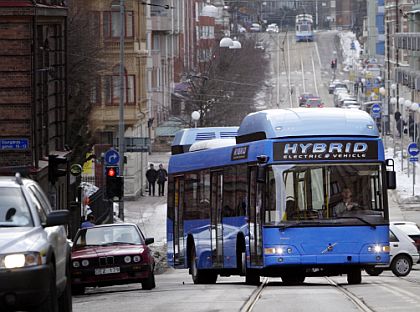
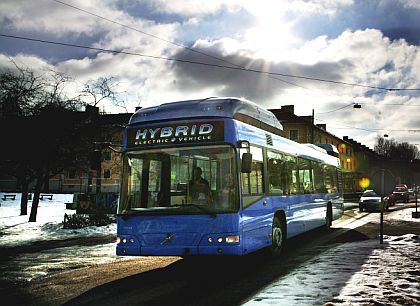
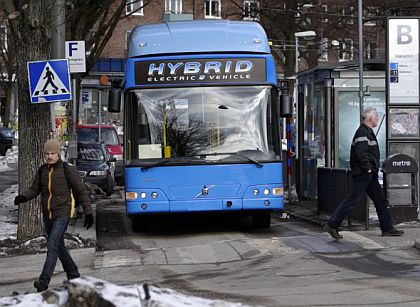



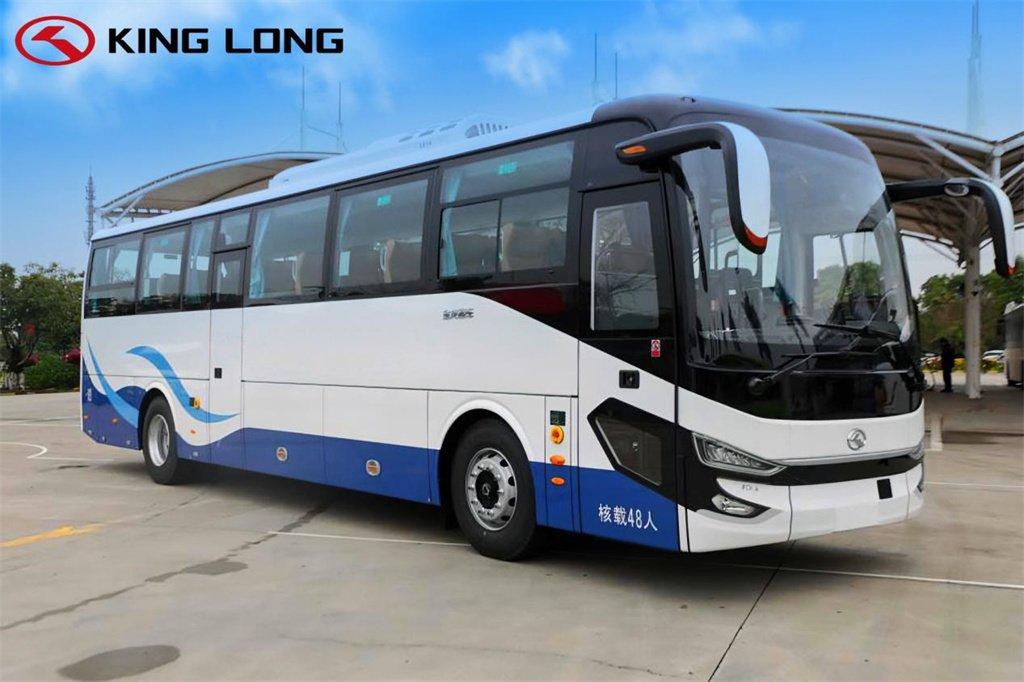 Dálkové elektrické autobusy v Číně
Dálkové elektrické autobusy v Číně
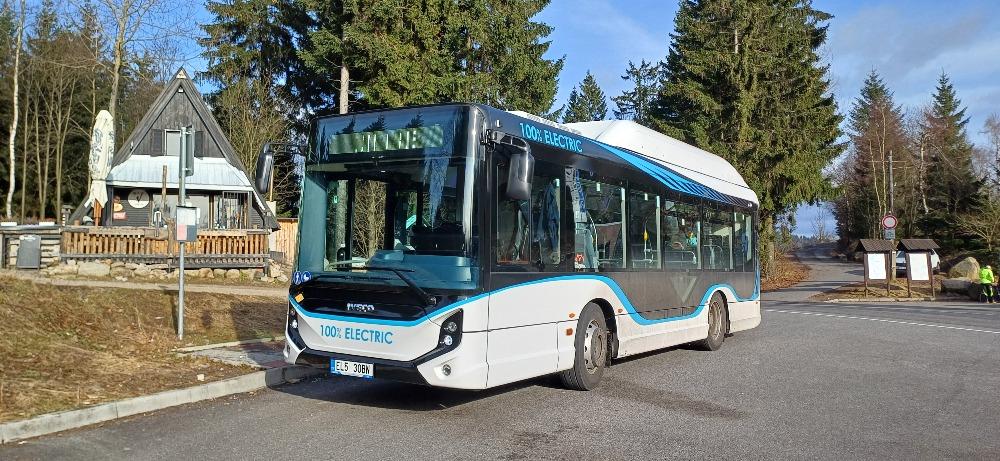 Jablonec nad Nisou zkouší elektrobusy
Jablonec nad Nisou zkouší elektrobusy
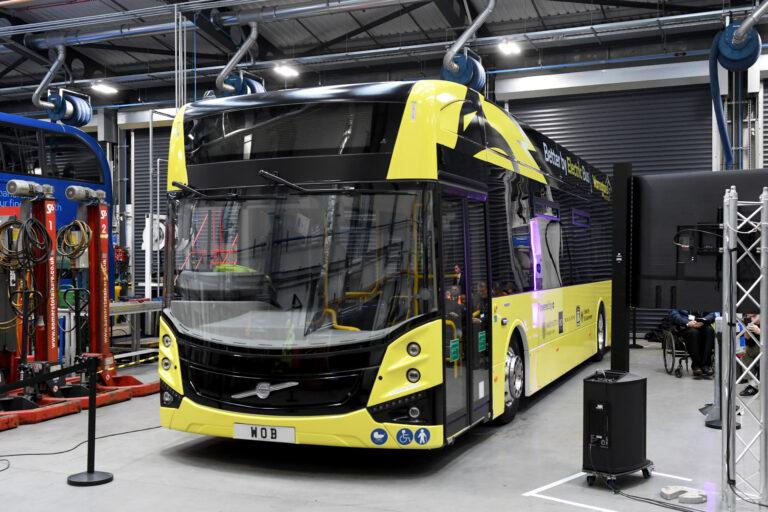 Volvo BZL pro Warrington v Anglii představeno
Volvo BZL pro Warrington v Anglii představeno








